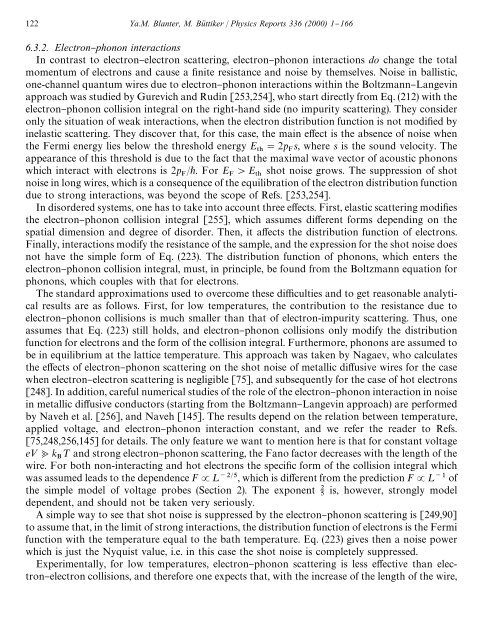shot noise in mesoscopic conductors - Low Temperature Laboratory
shot noise in mesoscopic conductors - Low Temperature Laboratory
shot noise in mesoscopic conductors - Low Temperature Laboratory
You also want an ePaper? Increase the reach of your titles
YUMPU automatically turns print PDFs into web optimized ePapers that Google loves.
122 Ya.M. Blanter, M. Bu( ttiker / Physics Reports 336 (2000) 1}166<br />
6.3.2. Electron}phonon <strong>in</strong>teractions<br />
In contrast to electron}electron scatter<strong>in</strong>g, electron}phonon <strong>in</strong>teractions do change the total<br />
momentum of electrons and cause a "nite resistance and <strong>noise</strong> by themselves. Noise <strong>in</strong> ballistic,<br />
one-channel quantum wires due to electron}phonon <strong>in</strong>teractions with<strong>in</strong> the Boltzmann}Langev<strong>in</strong><br />
approach was studied by Gurevich and Rud<strong>in</strong> [253,254], who start directly from Eq. (212) with the<br />
electron}phonon collision <strong>in</strong>tegral on the right-hand side (no impurity scatter<strong>in</strong>g). They consider<br />
only the situation of weak <strong>in</strong>teractions, when the electron distribution function is not modi"ed by<br />
<strong>in</strong>elastic scatter<strong>in</strong>g. They discover that, for this case, the ma<strong>in</strong> e!ect is the absence of <strong>noise</strong> when<br />
the Fermi energy lies below the threshold energy E "2p s, where s is the sound velocity. The<br />
appearance of this threshold is due to the fact that the maximal wave vector of acoustic phonons<br />
which <strong>in</strong>teract with electrons is 2p /. ForE 'E <strong>shot</strong> <strong>noise</strong> grows. The suppression of <strong>shot</strong><br />
<strong>noise</strong> <strong>in</strong> long wires, which is a consequence of the equilibration of the electron distribution function<br />
due to strong <strong>in</strong>teractions, was beyond the scope of Refs. [253,254].<br />
In disordered systems, one has to take <strong>in</strong>to account three e!ects. First, elastic scatter<strong>in</strong>g modi"es<br />
the electron}phonon collision <strong>in</strong>tegral [255], which assumes di!erent forms depend<strong>in</strong>g on the<br />
spatial dimension and degree of disorder. Then, it a!ects the distribution function of electrons.<br />
F<strong>in</strong>ally, <strong>in</strong>teractions modify the resistance of the sample, and the expression for the <strong>shot</strong> <strong>noise</strong> does<br />
not have the simple form of Eq. (223). The distribution function of phonons, which enters the<br />
electron}phonon collision <strong>in</strong>tegral, must, <strong>in</strong> pr<strong>in</strong>ciple, be found from the Boltzmann equation for<br />
phonons, which couples with that for electrons.<br />
The standard approximations used to overcome these di$culties and to get reasonable analytical<br />
results are as follows. First, for low temperatures, the contribution to the resistance due to<br />
electron}phonon collisions is much smaller than that of electron-impurity scatter<strong>in</strong>g. Thus, one<br />
assumes that Eq. (223) still holds, and electron}phonon collisions only modify the distribution<br />
function for electrons and the form of the collision <strong>in</strong>tegral. Furthermore, phonons are assumed to<br />
be <strong>in</strong> equilibrium at the lattice temperature. This approach was taken by Nagaev, who calculates<br />
the e!ects of electron}phonon scatter<strong>in</strong>g on the <strong>shot</strong> <strong>noise</strong> of metallic di!usive wires for the case<br />
when electron}electron scatter<strong>in</strong>g is negligible [75], and subsequently for the case of hot electrons<br />
[248]. In addition, careful numerical studies of the role of the electron}phonon <strong>in</strong>teraction <strong>in</strong> <strong>noise</strong><br />
<strong>in</strong> metallic di!usive <strong>conductors</strong> (start<strong>in</strong>g from the Boltzmann}Langev<strong>in</strong> approach) are performed<br />
by Naveh et al. [256], and Naveh [145]. The results depend on the relation between temperature,<br />
applied voltage, and electron}phonon <strong>in</strong>teraction constant, and we refer the reader to Refs.<br />
[75,248,256,145] for details. The only feature we want to mention here is that for constant voltage<br />
e
















